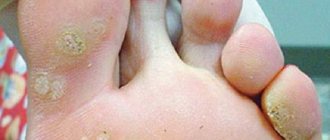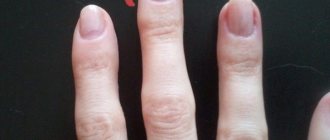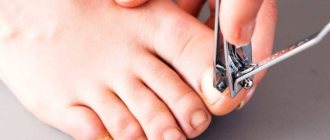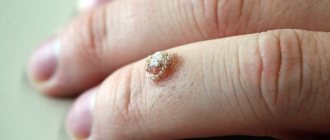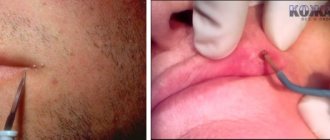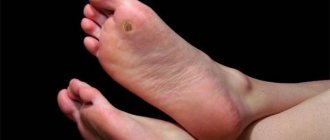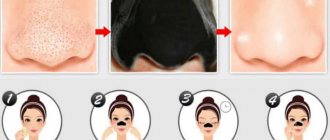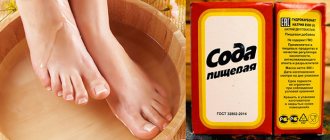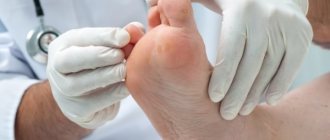The appearance of calluses filled with liquid is a protective reaction of the body to an external irritant. But, although watery callus is considered quite safe and does not require a special approach to treatment, improper care for it can cause quite serious troubles. You also cannot ignore the discomfort that it causes in a person, prompting you to get rid of chafing as quickly as possible. The question of how to get rid of water callus does not lose its relevance. But to prevent deletion from becoming a source of problems, you should study its features in as much detail as possible.
Causes of watery calluses
The main reason why dropsy forms is friction. It can be caused by uncomfortable clothing, shoes - anything that comes into contact with the skin. Constant friction from uncomfortable, tight clothing causes dropsy to appear in various parts of the body.
Water calluses on the hands appear as a result of prolonged work with household tools without gloves, or exercise with sports equipment.
Shoes that have not yet been worn in or, on the contrary, are too wide, incorrectly selected socks or the absence of them, cause the formation of water calluses on the feet. Sweaty feet and holes in socks also contribute to this.
Swelling, pain and increased sensitivity that appear on the skin are signs that the skin area is being rubbed. If you quickly remove these symptoms and give your skin a rest, you can avoid the formation of a callus.
Possible consequences
Calluses are a delicate problem. A minor defect can have serious consequences:
- suppuration of the blister leads to an inflammatory process in the body. The person feels unwell, weak, and the temperature rises;
- infection threatens the entry of bacteria into the bloodstream and the development of sepsis;
- an untreated process leads to a chronic course of the disease;
- a purulent lesion can be complicated by an abscess or phlegmon of the leg.
Calluses can appear due to rubbing from new or uncomfortable shoes, and subsequently cause a lot of inconvenience. At a minimum, when it comes into contact with any hard material, pain appears. Because of this, wearing shoes, sneakers, etc., becomes simply impossible.
Painful blister on the skin
Any person wants to pierce a callus as soon as possible in order to get rid of all this discomfort. Only now, if you perform this action incorrectly, then inflammation may form at the site of the problem, which is likely to cause even more pain. In addition, sooner or later a festering wound will have to be shown to a doctor, who will most likely prescribe long-term treatment.
To get rid of calluses, a patch is often used - it undoubtedly helps, but it is not always possible to wear it for a long time. In addition, if you correctly pierce an ordinary dropsy, it will heal several times faster, and at the same time, it will no longer be felt. Important! Most people believe that any patch cures a callus 100%. In fact, only those specimens that have been treated with a special medical compound are capable of this. Moreover, although the use of the patch is much safer, it will have to be worn for at least 1 week to be effective.
Is it possible to pierce
A small bubble will heal without puncturing. A large water callus, which causes pain and discomfort, needs a puncture so that it does not burst as a result of injury. In case of a puncture, healing will occur easier and more accurately than with a spontaneous rupture.
You can pierce the bladder yourself at home, following the rules of hygiene, but doctors still advise contacting the nearest specialist.
Important! People with diabetes or hypotension should consult a doctor before popping a blister on their own.
How to pierce correctly
To avoid infection and ensure rapid healing, you must follow a number of rules:
- Before piercing, treat damaged skin and hands with an antiseptic solution.
- Use a sterile needle. To disinfect, you can hold it over a fire or put it in alcohol for a few minutes.
- Make punctures on the sides of the callus, holding the needle parallel to the skin.
- If the callus is large, pierce it in several places to completely release the liquid.
- Use gentle movements to get rid of the liquid inside.
- It is better to pierce the first day after the formation of a blister.
- After the puncture, do not remove the covering skin under any circumstances; as it dries, it will come off on its own.
Folk remedies
Folk remedies can serve as an excellent alternative to piercing calluses. So, you can relieve inflammation and speed up the healing of calluses using:
- aloe;
- chamomile;
- propolis.
Let's look at how these tools are used.
aloe leaves
A freshly cut leaf of a three-year-old plant is washed under running water, placed in a refrigerator and left in it for two days. After the specified time has passed, the sheet is cut into several parts, applied cut side to the callus, covered with a film and fixed with a plaster or bandage.
Chamomile
Chamomile flowers are poured with boiling water and infused for several hours. The resulting infusion is diluted with warm water and used as a foot bath. The duration of the procedure in this case should be at least a quarter of an hour. After the specified time has passed, the feet are thoroughly dried, and Vishnevsky ointment is applied to the callus and a bactericidal patch is stuck on.
Propolis tincture
Used for preparing compresses, alternating with treatments with Vishnevsky ointment, Levomekol, Streptocide ointment.
How to treat
After all the liquid has come out of the callus, it is necessary to apply a sterile bandage with antiseptic ointment. It is better to use a patch special for calluses; a regular one can steam the skin on the wound. At night it is better to remove the bandage and let the wound dry, this will speed up healing.
Since the wound under the callus is very sensitive and has a high risk of infection and inflammation, the main treatment is to maintain antibacterial hygiene. Many people are concerned about the question of how to quickly cure water blister. It is quite possible!
Here are the most effective ointments for treating callus wounds:
- Levomekol – has pronounced antimicrobial and healing properties. Apply to a sterile bandage and apply to the wound. Change the bandage 3 times a day;
- Synthomycin ointment is an antimicrobial agent that helps relieve pain;
- Salicylic 10% ointment – has an analgesic and healing effect. Can be applied at night.
Water callus on the toe, how to treat
The formation of calluses on the toes is especially painful and inconvenient, because in this case it is impossible to wear closed shoes, even if the weather requires it, and even when walking the callus will cause discomfort. For the treatment of such calluses, a special callus patch is excellent. It must be applied to sterilized skin. When applied overnight, the patch absorbs liquid from the bladder, but at the same time prevents the wound from drying out due to its breathability. The next morning, the skin is removed along with the plaster and the wound from the callus is almost healed.
If there is a constant aching pain in the wound, the fluid inside becomes cloudy and the wound becomes hot - these are signs of infection in the wound. You should not self-medicate, you need to urgently contact a medical facility. The doctor himself will clean the wound, apply a bandage and prescribe antibacterial or other drugs, based on the situation.
Treatment of watery callus with folk remedies
In folk medicine, many are known to be effective for the treatment of dropsy.
Aloe
The plant, known for its antiseptic properties, also helps remove calluses. Place the cut aloe leaf on the wound, cut side down, so that the juice gets on it, and secure with a band-aid. The sheet needs to be changed every 6 hours.
Tea tree oil
To treat calluses, you need to mix vegetable oil with tea tree oil in a 3/1 ratio. Apply the resulting mixture 4 times a day. Perfectly protects against infections and inflammation.
Salt baths
The solution is prepared in a ratio of 1 tbsp. l. salt per liter of warm water. Do not use hot water so as not to injure the callus. Baths can be taken for no more than 5 minutes.
- Calendula and chamomile. Gauze soaked in a decoction of these herbs is applied to the wound. They have a healing soothing effect.
- Plantain. One of the most famous antiseptic plants. A paste is prepared from well-washed plantain leaves and applied to the wound as a compress 1 – 2 times a day.
- Potato compresses. Raw potatoes are passed through a blender or grated. The resulting pulp is applied to the wound and secured with a bandage on top.
- Kalanchoe. Also has an antiseptic effect.
Signs of infection and treatment options
The inflammatory process when pathogenic microorganisms enter the wound from a burst callus is characterized by the following symptoms:
- Painful redness around the callus;
- Tumor of the problem area;
- Increased temperature of the whole body;
- Suppuration of the wound surface.
If a wet, burst callus is complicated by inflammation, it is recommended to seek medical help. Before visiting a doctor, you can apply medicinal plants that have an anti-inflammatory effect to the problem area.
How to anoint a burst callus:
- Cut the spines along the edges of the aloe leaf and peel off the skin from the concave side. Apply the fleshy part to the wound and apply a gauze bandage. It is advisable to do the procedure at night;
- Apply a piece of Kalanchoe leaf, after removing its skin, to the inflamed wound;
- Before going to bed, steam the affected heel or toe in a warm solution of potassium permanganate. Wipe your leg dry, apply a plantain leaf, and apply a sterile bandage on top.
Medicinal plants (aloe, kalanchoe, plantain)
Prevention
The appearance of calluses is quite painful and unpleasant. Preventing them is easier than treating them, so follow these simple rules:
- When buying new shoes, choose only models made of high-quality material and suitable size, and check whether your feet are comfortable in them. Shoes worn out will definitely cause water blisters on your feet.
- Always wear socks under closed shoes.
- Apply the patch in advance to prevent the appearance of water calluses on the foot.
- When playing sports or long walks, wear only special shoes and socks that are made from natural materials and do not have rough seams. This will prevent water calluses on your feet.
- It is also worth paying attention to the heel of the shoes you purchase; if it is rough, a water callus appears on the heel.
- When performing work in the garden and garden, do not forget about protective gloves.
- You can use special anti-chafing pencils, such as Compeed.
- Since a humid environment is most favorable for rubbing, it is worth using talcum powder or other products that dry the skin.
By taking preventative measures in time, you can forever avoid encountering this painful and unpleasant problem.
Nutrition
During the recovery period, it is important to pay attention to nutrition, especially if the callus that burst on the heel turns out to be infected. The body's regenerative powers depend on nutrition. Recommended to eat:
Healthy eating
- more vegetables and fruits, which include vitamins and microelements necessary for a weakened body. The products are filled with fiber, which cleanses the intestines and allows the organ to work well;
- fermented milk products - enrich the body with beneficial lacto- and bifidobacteria, which form the basis of immunity. They are considered the basis of the fight against harmful microorganisms;
- foods rich in vitamin E, which is responsible for tissue regeneration: nuts, seeds, greens;
- a lot of liquid. Lack of moisture leads to dry skin and cracks, especially in areas of broken skin.
It is better to give up sweet and rich products that feed harmful microorganisms. Such food disrupts the normal functioning of the intestines. The series continues with products: fatty meat, lard, smoked meats, fast food, alcohol.
First aid
To prevent the risk of various complications from skin rupture, it is necessary to provide first aid correctly.
Before treating the damaged area, wash your hands thoroughly. Any antiseptic agent can be used.
The following drugs are suitable for this:
- Diamond Green;
- Hydrogen peroxide;
- Iodine;
- potassium permanganate;
- Furacilin;
- Chlorhexidine;
- Miramistin.
After treatment with a disinfectant, an antibacterial patch is applied to the damaged area.
Step-by-step instruction
If a callus bursts, then to provide first aid you need to do the following:
- Wash your hands with soap and treat them with alcohol.
- Lubricate the edges of the wound with brilliant green or iodine. When these medications penetrate the wound, healing slows down.
- Apply a special plaster (bactericidal) to the damage.
- If the burst bubble is large, then a bandage is made from several layers of bandage, which is attached to the wound with ointment.
To heal the wound, it is necessary to carry out treatment several times a day with ointments and adhesive plasters, which are produced specifically for wet calluses.
